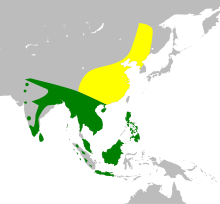Indian cuckoo
| Indian cuckoo | |
|---|---|
.jpg) | |
| A male juvenile | |
| Scientific classification | |
| Kingdom: | Animalia |
| Phylum: | Chordata |
| Class: | Aves |
| Order: | Cuculiformes |
| Family: | Cuculidae |
| Genus: | Cuculus |
| Species: | C. micropterus |
| Binomial name | |
| Cuculus micropterus (Gould, 1837)[2] | |
 | |
The Indian cuckoo (Cuculus micropterus) is a member of the cuckoo order of birds, the Cuculiformes, that is found in the Indian subcontinent and Southeast Asia. It ranges from India, Bangladesh, Bhutan, Nepal and Sri Lanka east to Indonesia and north to China and Russia. It is a solitary and shy bird, found in forests and open woodland at up to 3,600 m.
Description
This is a medium-sized cuckoo with both sexes alike. It has grey upperparts while the underside has broad black barring. The tail is barred with a broad subterminal dark band and a white tip. Young birds have white markings on the crown and white chin and throat contrasting with a dark face. Juveniles are browner and have broad white tips to the head and wing feathers. The eye-ring is gray to yellow (a feature shared with the common hawk-cuckoo). The iris is light brown to reddish. The female differs from the male in being slightly paler grey on the throat and in having more brown on the breast and tail. The barring on the belly is narrower than in the male. Nestlings have an orange-red mouth and yellow flanges to the gape.[3]
 |
|
| Problems playing this file? See media help. | |
 |
Indian cuckoo call
Call recorded in the Central Himalayas, May 2008 |
| Problems playing this file? See media help. | |
The call is loud with four notes. They have been transcribed as "orange-pekoe", "bo-ko-ta-ko", "crossword puzzle" or "one more bottle". In Bengali, it is interpreted as "bou-kotha-kao", "Bride, please speak". In Uttarakhand and Nepal, it is rendered as "kafal pako", or "the kafal fruit is ripe", as is the case in May–June when calling increases. Very little variation is noted between regions. In the Kangra Valley of India, the call is interpreted as the soul of the dead shepherd uttering "where is my sheep".[3][4] In China, one of the names (simplified Chinese: 四声杜鹃; traditional Chinese: 四聲杜鵑; pinyin: sìshēngdùjuān) means "four-note cuckoo".[5] In northern India, they are locally common in the breeding season with as many as a calling bird for every 2 square km.[3]
They feed on hairy caterpillars and other insects but sometimes take fruits.[3] They usually feed on the upper canopy, gleaning insects, sometimes making aerial sallies for flying termites or rarely even by hovering lower near the ground.[6]
Taxonomy and systematics
Two subspecies are generally recognized. The nominate form is found in much of continental Asia, while concretus S. Müller, 1845 which is smaller and darker is known from the Malay Peninsula, Java, Sumatra and Borneo. The birds in the Amur region are larger and Swinhoe described a form from northern China as Cuculus michieanus while Walter Norman Koelz described a form fatidicus from northeastern India.[3]
Distribution and habitat
The species is found widely distributed across Asia, from the Indian subcontinent eastwards to Southeast Asia. The preferred habitat is deciduous and evergreen forests but also occur in garden lands and thick scrub.[3]
Some populations appear to migrate south in winter, although there are breeding populations in the southern areas as well,[7] with specimens netted at night or recorded at lighthouses.[3]
Behaviour and ecology
The Indian cuckoo is a brood parasite. It lays its single egg mostly in the nests of drongos and crows. It removes and eats an egg from the host nest before laying its own. The breeding season varies from May to July in northern China, March to August in India, January to June in Burma and January to August in the Malay Peninsula.[3]
The host species include Lanius cristatus in the Amur region, black drongo and Pica cyanea in China. In India, they have been found to be fed by black drongos and ashy drongo. Other hosts that have been recorded include black-headed oriole,[8] streaked spiderhunter, Eurylaimus ochromalus and Dicrurus paradiseus.[3]
The eggs of the cuckoo hatch in 12 days while those of the brown shrike in the Amur region take 14 days. During the third or fourth day, the young bird bends its back when touched and heaves out other eggs or nestlings. This instinct is lost soon after.[5]
References
- ↑ BirdLife International (2012). "Cuculus micropterus". IUCN Red List of Threatened Species. Version 2013.2. International Union for Conservation of Nature. Retrieved 26 November 2013.
- ↑ Gould, John (1837) Proceedings of the Zoological Society of London p. 137 (Himalayas)
- 1 2 3 4 5 6 7 8 9 Payne, RB (2005). The Cuckoos. Oxford University Press. pp. 25, 101, 492–494.
- ↑ Whistler, H. (1926). "The birds of the Kangra District, Punjab. Part 2.". Ibis. 2 (12th Series): 724–83.
- 1 2 Neufeldt,I (1966). "Life history of the Indian Cuckoo Cuculus micropterus micropterus (Gould) in the Soviet Union.". J. Bombay Nat. Hist. Soc. 63 (2): 399–419.
- ↑ Narayan,Goutam; Rosalind,Lima (1991). "Hovering: an unrecorded behaviour in the Indian Cuckoo Cuculus micropterus.". J. Bombay Nat. Hist. Soc. 88 (3): 454.
- ↑ Prasad,JN; Jayanth,MS (1993). "A record on Indian Cuckoo breeding in Bandipur, Karnataka.". Newsletter for Birdwatchers. 33 (3): 45.
- ↑ Phillips,WWA (1952). "The Indian Cuckoo - Cuculus micropterus micropterus - in Ceylon.". J. Bombay Nat. Hist. Soc. 51 (1): 274–275.
Other sources
- Sankar,K (1993) The Indian Cuckoo (Cuculus micropterus micropterus Gould) in Sariska Tiger Reserve, Rajasthan. J. Bombay Nat. Hist. Soc. 90(3):512
- Hewetson, C. E. (1956) Observations on the bird life of Madhya Pradesh. J. Bombay nat. Hist. Soc. 53(4):627
